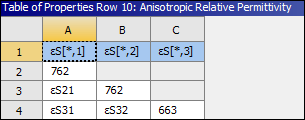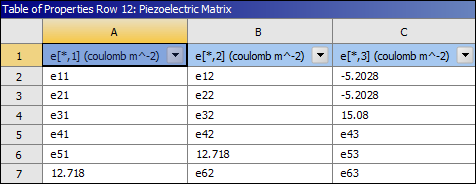Material properties are defined in the Engineering Data tab of Workbench.
Table 39.1: Structural Material Properties (taken from Yan [1])
| Damping Ratio Material | ||||
| Material Property | Alumina | Aluminium | Steel | Titanium |
| Young’s modulus (N/m2) | 3e11 | 7e10 | 2.1e11 | 1.1e11 |
| Poisson’s ratio | 0.2 | 0.3 | 0.3 | 0.32 |
| Density (kg/m3) | 3720 | 2700 | 7800 | 4430 |
Piezoelectric materials typically have orthotropic material properties, although isotropic materials are assumed in this example, as they are defined in that manner in the reference.
Note: The Piezoelectric Matrix and Anisotropic Relative Permittivity defined in Engineering Data must be defined at constant stress and constant strain, respectively or vice-versa as shown in the table below. Both properties defined at constant stress or constant strain is not recommended.
Table 39.2: Piezoelectric Material Properties (taken from Berlincourt [3])
| Material Property | Piezoelectric Material |
| Young’s modulus (N/m2) | 9.2e10 |
| Poisson’s ratio | 0.33 |
| Density (kg/m3) | 7700 |
|
Anisotropic Relative Permittivity  |
 |
|
Piezoelectric Stress Matrix  |
 |
A system damping ratio of 0.1 percent is assumed for the model, as the ultrasonic transducer has very little damping. The material dependent damping is defined in Engineering Data for all materials.



